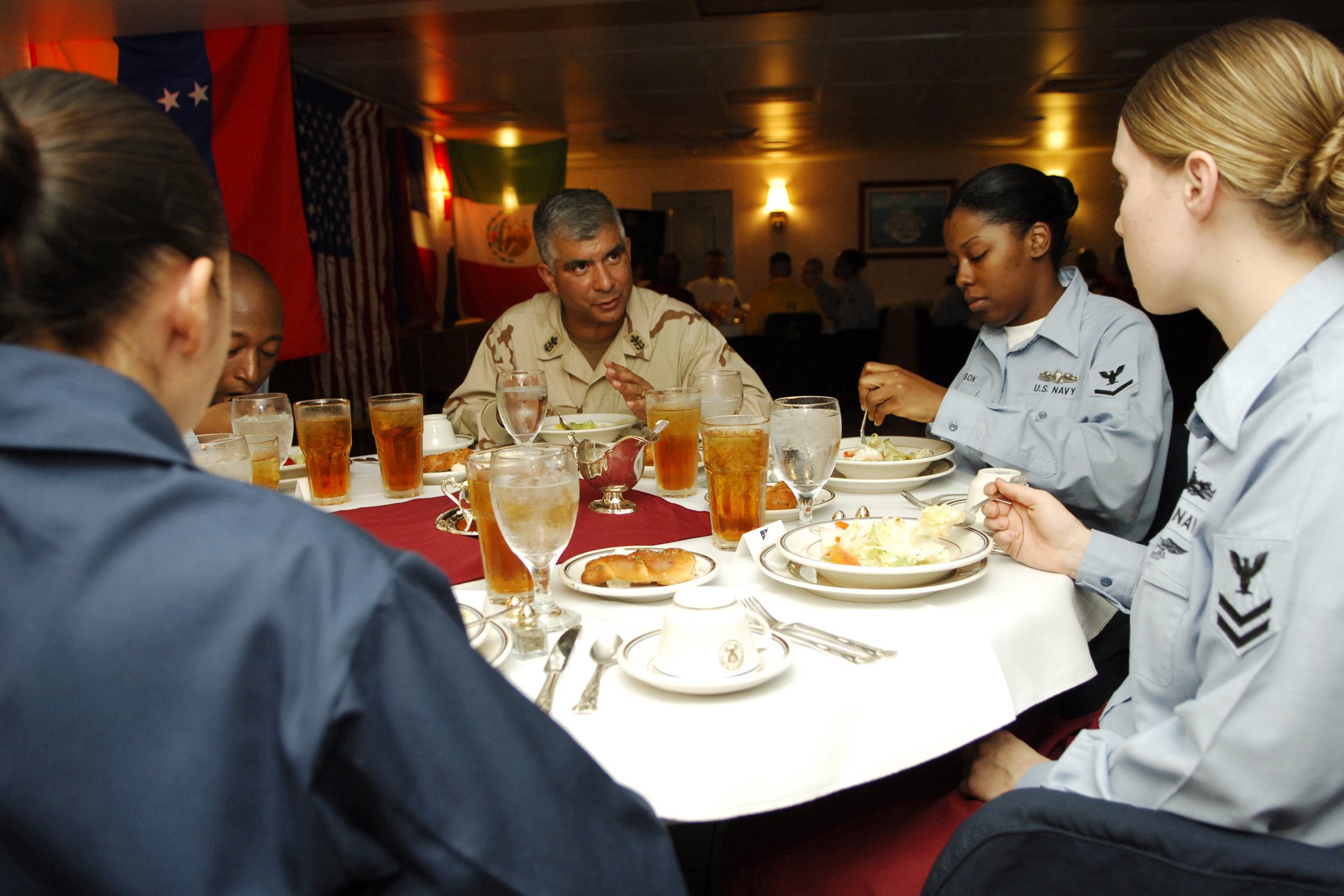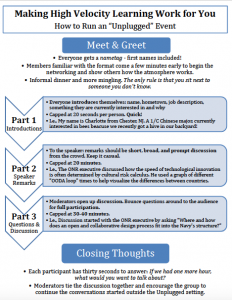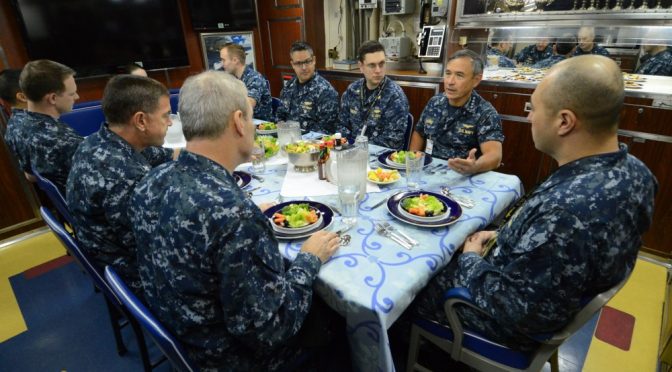By Charlotte Asdal and Scotty Davids
On a recent Wednesday evening, fifteen midshipmen gathered in the company of a Maersk captain and a handful of Navy officers of all ranks. Their roles in the hierarchy seemed clear. However, over the course of two hours, dynamic exchanges about piracy, leadership at sea, and market efficiency had everyone on the edge of their seats. Conversation flowed freely between the experienced and the novice, and across a wide spectrum of professional interests. By the end of the night, what was left was simply a group of people eager to learn from one another. What happened? High velocity learning.
CNO ADM Richardson discusses his vision for a Navy that embraces High-Velocity Learning. Credit: Naval Post-Graduate School.
The Navy recently issued a Design for Maintaining Maritime Superiority in which Chief of Naval Operations (CNO) Admiral Richardson outlined an effort to “achieve high velocity learning at every level.” What does that mean? The concept of high velocity learning challenges us to reinvigorate a culture of assessment and strive to increase the speed of our learning cycle. This seems to have been confusing to many in the Fleet, especially for those of us many rungs down the ladder from the CNO. How can we implement his guidance?
Take Charge and Move Out
We think we have figured out one way to do it here at the United States Naval Academy. Taking into account the CNO’s call for seizing the initiative in achieving high velocity learning, we know that you don’t always have to wait for a program to be enacted and passed down to your command. You can execute immediately based on commander’s intent. In this case, we call it “Unplugged.”
Once a month for the past two years, a group of fifteen midshipmen, some junior officers, a few senior officers, a senior enlisted leader, a handful of civilians, and one discussion leader have piled into a living room for a conversation. Hosted at a senior officer’s home after hours, “Unplugged” is something different. It is a casual venue for focused dialogue and exchange of ideas. In the past two years, our discussion leaders have included an executive from the Office of Naval Research (ONR), the Mayor of Annapolis, a Maersk captain, submariners, and astronauts. “Unplugged” brings together people from different circles, with different levels of experience, and those who would not usually interact. The speakers are experts in their fields. Spots for participants are first-come, first-serve with no expectation of subject matter expertise. Officer and senior enlisted participants facilitate discussion of Fleet applications.

Making “Unplugged” Different
These key tenets of making conversation a success can be applied at any level and in any command that wants to engage its Sailors: dialogue, setting, and spectrum of experience. Midshipmen, more than many others, are afforded visits from former Presidents, Ambassadors, and senior executives. We crowd into Alumni Hall and, frankly, decide in the first five minutes of a presentation how much effort we will put into staying awake. What makes “Unplugged” special is the personal interaction. We listen to a speaker with years of expertise and then are asked, “What are you thinking?” It forces us to be inquisitive and thoughtful about the topic at hand. Participants leave with an opinion on the topic, a problem with which to grapple, and more questions than could be possibly answered in a two hour session. Processing new and challenging information while developing a questioning mindset are skills necessary for all future officers.

The atmosphere created by a home-cooked meal in a living room takes midshipmen and senior attendees alike out of the monotonous classroom or lecture setting. It makes the event informal; there is less of an expectation to be taught a subject and more of an inclination to engage in discussion. This setting is effective at the Academy because the home-cooked meal is so rare, but this could be implemented anywhere that takes the attendees out of their normal environment.
It is also invigorating to sit down next to a Navy commander and share ideas and excitement about the night’s topic. As the discussion leader wraps up his or her points to start the discussion, there are no fewer questions from the senior attendees than there are from the midshipmen. Because of the range of experience, input can come from every possible interest in the room. This dialogue gives the speaker, midshipmen, and senior attendees a chance to relate the topic to their operational area, and to express both praise and critical questions. Senior and junior officers at “Unplugged” use their experiences to invaluably relate the discussion topic to how we fight and operate in the Fleet.
This leads to more conversation, spreading from class, to company, to the Brigade. Those who are most engaged, most thoughtful, and most inquisitive are invited back to help lead the next conversation. Walking out of an “Unplugged” event, participants are buzzing with ideas. They are energized about their futures and are itching to continue the conversation. Participants all interact with people whom they thought were out of reach. But in these challenging conversations with senior level experts, their ideas and questions are entertained, explored, and given credence.
The “velocity” in High Velocity Learning implies both a speed and a direction. We incorporate not only an energizing discussion, but also seek an endstate. At USNA, our endstate is getting as many midshipmen involved as possible, building confidence in them to engage in these discussions, and encouraging the thoughtfulness to ask more challenging questions. After “Unplugged” with the ONR executive, we asked, “How does the Navy’s risk calculus affect its ability to innovate?” After the Mayor, we asked, “What can we learn from local leaders about how to manage a team?” After the Maersk captain, we asked, “How might we work better with our commercial shipping counterparts?” Every participant offers unique value to the discussion.

Conclusion
We have taken Big Navy’s objectives to heart and made them successful on a small scale. To us, high velocity learning means a problem solving mindset. It is the ability to frame the problem, evaluate what we do and do not know, and devise and act on a way forward. “Unplugged” is a forum through which we develop this method of learning. The goal is to continue the momentum of the conversation and spread the excitement about thinking, reading, and discussing relevant challenges to the Navy team. As midshipmen, we often do not have access to these conversations that are so critical to our future careers. It isn’t that we lack interest, but rather some discussions are not accessible to us or we don’t know where to look. “Unplugged” bridges this gap and gives midshipmen confidence and access to the dialogue.
Try it within your peer group. We guarantee you will walk away invigorated and ready to continue the conversation. This is high velocity learning.
Charlotte Asdal and Scotty Davids are both first-class midshipmen at the U.S. Naval Academy. Charlotte is studying Chinese and from Chester, NJ. Scotty is a mechanical engineering major from Boulder, CO.
Featured Image: Bangor, WA (May 20, 2014) – Adm. Harry Harris chats with USS Louisiana (SSBN 743) Gold Crew officers in the boat’s wardroom. (U.S. Navy photo by Chief Mass Communication Specialist Ahron Arendes/Released)





 who now works in the office of Senator John Thune (R-SD). During the
who now works in the office of Senator John Thune (R-SD). During the